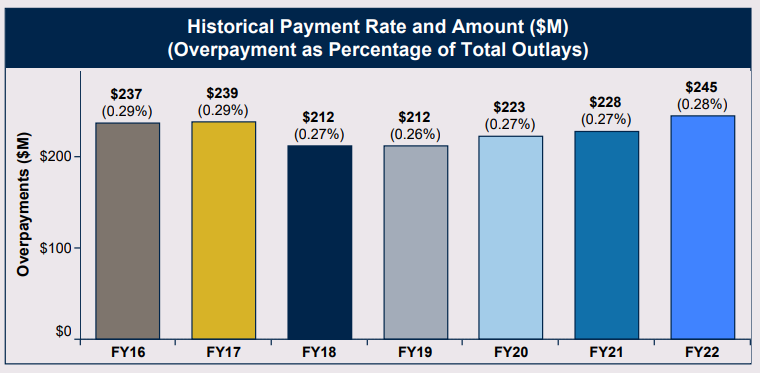Improper payments reach five-year high in OPM retirement services
Improper payments in retirement services have been gradually escalating for the last several years, but the Office of Personnel Management is taking steps to try to...
As improper payments in the Office of Personnel Management’s retirement services division continue to climb, the agency is taking steps to try to reduce the hundreds of millions of dollars that it distributes in error annually.
Improper payments in OPM retirement services have been gradually escalating for the last five fiscal years. OPM’s retirement services is the agency division that manages retirement applications, accounts and annuity payments for millions of retired federal employees and their survivors.
Most recently, during fiscal 2022, OPM improperly paid close to $326 million — a combination of both overpayments and underpayments — to federal annuitants and survivors, according to a December 2023 report from OPM’s inspector general (IG) office.
In overpayments alone, OPM distributed about $245 million improperly during fiscal 2022. The steady growth in improper payments comes after a dip in the numbers between fiscal 2017 and fiscal 2018.

Annuitant deaths that are either unreported or unknown to OPM are the number one cause of improper payments in retirement services, the IG report said.
“These unreported deaths may allow payments to continue because of program vulnerabilities or intentional fraud on the part of bad actors,” the report said. “Sometimes … improper payments continue for years and cost tens of thousands of dollars before discovery.”
Other trends in improper payments that OPM’s IG has investigated deal with instances of fraud, forged documents, elder abuse and mismanagement of funds, the report said.
The IG report also detailed several individual cases in which improper payments went on long enough to result in hundreds of thousands of dollars in funds being improperly distributed.
In one example, the death of a survivor annuitant in 2001 went unreported to OPM until 2019. During those 18 years, OPM paid out $256,754 to an ineligible individual, and recovered just $1,373 through the Treasury Department’s reclamation process. In August 2023, the subject of that investigation signed a settlement agreement with the U.S. Attorney’s Office for the Western District of Texas to repay $60,000 to OPM over the next few years, the IG report said.
In another example, OPM had received a tip in 2019 about an annuitant’s death that had gone unreported since 2008, resulting in $428,410 in improper overpayments. Similar to the first case, OPM was initially able to recover just $1,640. The individual in this case, who pleaded guilty to government property theft charges, has been ordered to repay the remaining funds that OPM improperly paid out, the IG report said.
OPM’s plans to address improper payments
In response to recent IG reports, OPM Director Kiran Ahuja said in a Nov. 13 letter to OPM IG Krista Boyd that there should be more distinction between overpayments, which amount to about $245 million, and underpayments, amounting to about $81 million, during fiscal 2022. Additionally, Ahuja said, when comparing against the billions of dollars in payments made through retirement services, improper payments account for just about 0.35%.
OPM has started taking steps to try to address the issue as well. In 2019, OPM created a “fraud branch” in its retirement services division. The branch aims to address improper and fraudulent payments by investigating individual reports of fraud. The fraud branch is also tasked with referring cases of improper payments to the IG for further review.
Although there have been improvements in the investigation activities of the fraud branch, the number of deferrals overall is declining.
“The OIG still receives fewer than expected referrals from the fraud branch,” an October 2023 IG report on OPM’s top management challenges said.
Over the last five years, the OIG has received 158 fraud referrals from the retirement services program office, the IG report said.
In response, Ahuja said the cases that get referred to the OIG still fall within the established $30,000 threshold — and the fraud branch thoroughly investigates the remaining cases.
Additionally, the retirement services division plans to submit proposed revisions to update and clarify roles and responsibilities of the fraud branch.
“The proposed revisions will broaden fraud branch’s responsibilities to identify, refer and prevent fraud, including cases involving deceased annuitants,” Ahuja said.
Moving forward, OPM’s retirement services division is also working to improve surveys by moving them to a digital format on OPM’s Services Online platform, “eliminating the need for paper and streamlining the process to identify disabled annuitants who have returned to work,” Ahuja added.
OPM’s IG office said improvements will be largely tied to the modernization of retirement services overall.
“Reducing improper payments related to OPM’s retirement programs is intrinsically related to modernizing OPM’s retirement systems,” the October IG report said. “Stronger program integrity functions and root cause analysis of improper payments are areas where OPM, concurrently with its modernization efforts, can better prevent improper payments.”
Improper payments governmentwide
Many other federal programs across agencies have similar challenges with improper payments. These are payments that agencies have made either in incorrect amounts — or that shouldn’t have been made in the first place.
Since fiscal 2003, agencies’ improper payments have totaled nearly $2.4 trillion, according to an estimate from the Government Accountability Office.
In fiscal 2022 alone, agencies governmentwide made an estimated $247 billion in payment errors. Overpayments accounted for about $200 billion of that total.
“Improper payments continue to be an area of fiscal concern in the federal government,” GAO said in a March 2023 report.
Since 2009, the Office of Management and Budget has tracked trends in improper payments. OMB compiles an annual “scorecard” of a few dozen federal programs considered to be at the highest risk for improper payments. OPM’s retirement services has remained on that list for several years.
Of the 29 federal programs on the list for fiscal 2023, 10 saw their improper payments increase in the last year. Another 12 programs had decreases in their improper payments. Six were new to the list this year and therefore had no comparative data.
For OPM, in addition to the upward trend of the amount of improper payments, the agency’s recovery rate of those payments has been declining for at least the last five years, the scorecard showed.

Take the data with the “biggest grain of salt”
But the problems run even deeper — there’s a lack of reliability in how agencies estimate and report their improper payments, said Linda Miller, a former Government Accountability Office (GAO) official and former deputy executive director of the Pandemic Response Accountability Committee (PRAC).
“I take [the reports] with the biggest grain of salt,” Miller, founder and CEO of Audient Group consulting firm, said in an interview. “You just see steady increases with the same root causes and an inability to verify data. These reports aren’t good, but that doesn’t seem to be bothering anyone. Why is there so little scrutiny?”
Part of the problem is that the data agencies and IG offices rely on to create improper payment reports is often limited or incomplete. For OPM, many of the improper payments that the agency makes through retirement services may stem from limited data, on account of not using enough analytics to identify beneficiaries who have died and therefore are no longer entitled to the benefits, Miller said.
“There is more than one way of identifying people who have passed away — looking at Social Security, obituary data and more accurate information on deaths,” Miller said. “OPM doesn’t use much of that data, so the reports are likely less accurate.”
Similar limitations extend to other federal programs as well. That means OMB’s scorecard of high-risk programs leaves room for potential errors in the final numbers.
“OMB does not review the reports to identify issues that may warrant revision to the scorecard’s format and content, and OMB does not document and communicate to IGs its consideration of any such issues noted in the reports,” GAO said in a September 2023 report. “These steps can increase collaboration between OMB and IGs of agencies with high-priority programs.”
Copyright © 2025 Federal News Network. All rights reserved. This website is not intended for users located within the European Economic Area.
Drew Friedman is a workforce, pay and benefits reporter for Federal News Network.
Follow @dfriedmanWFED






